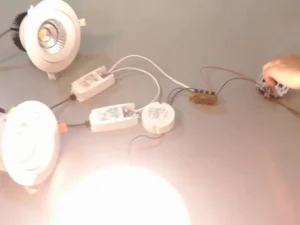介绍:
Lights have a great deal of effect on our mood and how we perform our work. These days, modern technology is even used in bulbs. Moreover, controlling how much light we want has never been easy—all thanks to TRIAC dimmers.
We all know the importance of dimmers in the world of lights. Well, what is TRIAC dimming? Are you familiar with it? This blog will explain it in detail.
We will discuss TRIAC dimmers, their role, and their types. So, let’s proceed to the blog and explore everything you need to know.
What is a TRIAC Dimmer?
A TRIAC dimmer is an electric switch that allows us to control the amount of light we want. TRIAC refers to a Triode for Alternating Current. When you use TRIAC dimming, you can adjust the power going to the light source. It is a simple system that helps you vary the amount of light. These switches work well with CFLs, halogens, and LED light bulbs.
What is TRIAC dimming? TRIAC is a type of semiconductor which we refer to as a thyristor. It belongs to the category of controllable rectifiers. This conductor has a special feature that can limit the amount of AC flowing through the lamp. This is how it controls the amount of light. We will discuss it later in the sections.
These dimmers are used in commercial and residential spaces and spaces where lights need to change according to demand. These spaces can include restaurants, hotels, theaters, and the hospitality industry. Dimmer switches are also present in many industries, including transportation, agriculture, and military research.
Understanding The Working of a TRIAC Dimmer

We are now aware of TRIAC switches. But how do they work? What mechanism do these switches follow? Let us explain in simple terms.
A thyristor is a special device with a three-electrode design. It contains a gate, an anode, and a cathode. Also, they can work well if the current passes through the gate. What happens after that?
Well, when the current passes through the gate, the circuit closes. Thus, it turns on the light bulb. In the other case, the bulb turns off if the current stops through the circuit. So, in a normal scenario, the bulb will run at its highest power because of the normal amount of current it gets. This constant current gives the bulb a regular supply of power.
However, a TRIAC dimmer limits the current supply to the bulb by sending the current in pulses. So, the bulb appears dim to our human eye because it gets on and off regularly hundreds of times in a second. TRIAC extends the delays between the electrical pulses to make the bulb even dimmer. Thus, these dimmers are a comfortable option for controlling the lighting system.
Let us explore their work more in phases. These are:
Phase 1: Getting to Know a Thyristor
A thyristor is a simple three-electrode semiconductor. It provides the current to flow in a two-way manner through a cathode and anode (positive and negative AC).
So, the TRIAC switch provides small pulses of current to the gate at intervals. Thus, the current flowing in small intervals rather than in a constant phase dims the bulb.
Phase 2: Automation of Capacitor
What are capacitors? Capacitors are small electronic devices that store energy. Once they get a full charge, they release this electrical energy.
We keep a small capacitor near the gates of a TRIAC. So, the bulb is off when the gate there is no current passing through the circuit. Here, the capacitor is charging. After the charge is complete in the capacitor, it triggers the gates. As a result, the light bulb gets on.
The gate closes once the alternating current (AC) wave turns positive to negative. In this case, the light bulb turns off again. What happens now? The capacitor will get to its full charge again. The only difference this time is a negative voltage waveform. Once in full charge again, the circuit observes the gate triggering.
The charging rate of the capacitor is determined by its capacitance. Capacitance refers to the capacitor’s ability to store electrical charge. The smaller the capacitance, the less electricity is required to charge it, and vice versa.
Phase 3: Controlling the Potentiometer
Do you know that even the timing of the gate trigger can be under control? Yes! One can control the timing by using a variable resistor as a potentiometer. We get these standard potentiometers as a dial or knob. We can take a common example as that in a sound system.
What is the role of having such a potentiometer? The primary role of a potentiometer is to change the total amount of current. Here, we are talking about the current going into the capacitor. It thus directly affects the duration of pulses that the light source experiences.
Special Note: We do not observe any digital controller in a TRIAC dimmer. It is about calculating capacitors and resistors to control the gate timings.
Phase 4: Dimmer Control of TRIAC
We are at the final phase of this dimmer control. How does this TRIAC dimming work? The TRIAC dimmer gets the input voltage and thus regulates it. It does this by stopping the voltage from going to the source of light.
In coordination, potentiometers and capacitors work by supplying current in a temporary manner. It is important to note that this current is in shorter pulses. In contrast, longer pulses will result in brighter lights. Thus, we use shorter pulses.
What are the Types of Dimmer Switches?

Do you know that a TRIAC dimmer switch can come in different formats? We need to install a TRIAC dimmer switch in various housing switches that can enhance them. Well, the following are the types of TRIAC dimmer switches that we can use in various settings:
-
3-Way/4-Way Switches
Three-way dimmer switches are complex. It can potentially control one or more bulbs from two locations. These switches are designed using a four-wire design. How? Here, we replace a neutral wire with a pair of traveler wires.
But, the four-way switches control lighting at the leading edge. How does a leading-edge work? The dimming halts an AC flow when the waveform reaches zero. It starts its back up when the wave reaches its peak.
-
Multi-Location Switches
Multi-location dimmers are the preceding version of a 4-way dimmer switch. They allow one to control the lighting system from more than three sources. They have one more advantage.
We can use multi-location switches for varying dimming zones. Yes, you can use these switches if you need variability in dimming zones. Yes! As an advantage, you can get two different dimming settings at two different places.
These switches deliver amazing benefits when we consider large spaces. For example, these can be restaurants, large offices, etc. They are one of the most used TRIAC dimmers for LED lighting because they work well in an LED dimmer circuit.
-
Single Pole Switches
The concept of a single-pole switch is pretty easy to understand. These switches can be used to control one light at once, and their design is simple and effective.
Moreover, these switches use a simpler version of wire design, a three-wired concept. We see these normal wires in a circuit: live, neutral, and ground. Also, these have a single on/off switch and a brightness control dial.
-
Plug-In Switches
You can wire a plug-in switch into a wall socket. It is because they are external dimming drivers. In simple terms, they act like an extension cable. Yes! You can connect them to the light source of your choice and can control the brightness.
But keep one thing in consideration when you use them. The light source you want to connect must be dimmable. It will only work in those scenarios. So, if you do not want the mess of wiring a permanent dimmer, you can use these plug-in switches.
-
Smart Switches
We are in the era of developing technology. Smart switches are the right example of this. We can connect these switches with our smartphones. It then allows us to control the lighting from wherever we want.
You can learn full control of these switches by reading the manual and contacting the experts. They also allow you to schedule the time of your light, a major development in TRIAC dimming.
Wrapping Up!
Thus, we have completed our discussion of TRIAC dimming. They act as a comprehensive solution and allow us to control the amount of light we want. We can create an amazing ambiance of our choice, all by using these dimmers.
